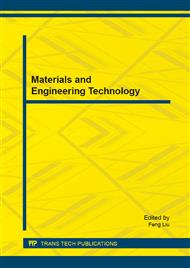[1]
C. Berrou, A. Glavieux, P. Thitimajshima, Near Shannon limit error-correcting codes and decoding: turbo-codes, Proc. IEEE Int. Conf. Commun., Geneva, Switzerland, 1993, pp.1064-1070.
DOI: 10.1109/icc.1993.397441
Google Scholar
[2]
J. Sun, O. Takeshita, Interleavers for Turbo Codes Using Permutation Polynomials Over Integer Ring, IEEE Trans. on Inform. Theory, vol. 51, no. 1, pp.101-109, (2005).
DOI: 10.1109/tit.2004.839478
Google Scholar
[3]
A. Nimbalker, T. K. Blankenship, B. Classon, T. E. Fuja, D. J. Costello Jr., Contention-free interleavers, Proc. 2004 IEEE Int. Symp. Information Theory, Chicago, IL, 2004, p.52.
DOI: 10.1109/isit.2004.1365089
Google Scholar
[4]
LTE; Evolved Universal Terrestrial Radio Access(E-UTRA); Multiplexing and channel coding(3GPP TS 36. 212 version 10. 6. 0 Release 10), ETSI TS 136 212 V10. 6. 0, 2012-07.
Google Scholar
[5]
O. Y. Takeshita, On maximum contention-free interleavers and permutation polynomials over integer rings, IEEE Trans. Inform. Theory, vol. 52, no. 3, pp.1249-1253, (2006).
DOI: 10.1109/tit.2005.864450
Google Scholar
[6]
Charles C. Wang, On the Performance of Turbo Codes, IEEE Military. Conf. on Comm., vol. 3, pp.987-992, (1998).
Google Scholar
[7]
Hongyu Zhao, Pingzhi Fan, On the equivalence of interleavers for turbo codes using quadratic permutation polynomials over integer rings, IEEE Commun. lett., vol. 14, no. 3, pp.236-238, (2010).
DOI: 10.1109/lcomm.2010.03.091695
Google Scholar
[8]
Rostislav Dobkin, Michael Peleg, Ran Ginosar, parallel interleaver design and VLSI architecture for low-latency MAP turbo decoders, IEEE Transactions on very large scale integration systems, vol. 13, no. 4, pp.427-438, (2005).
DOI: 10.1109/tvlsi.2004.842916
Google Scholar
[9]
A. Giulietti, L. Van der Perre, M. Strum, parallel turbo coding interleavers: avoiding collisions in accesses to storage elements, IEEE Electronics lett., vol. 38, no. 5, pp.232-234, (2002).
DOI: 10.1049/el:20020148
Google Scholar
[10]
Orhan Gazi, Ozgur Yilmaz, Collision free row column S-random interleaver, IEEE Commun. lett., vol. 13, no4, pp.257-259, (2009).
DOI: 10.1109/lcomm.2009.082142
Google Scholar
[11]
Na Guo, WenPing Ma, Sheng Gao, Tao Ruan, Novel parallel interleaver based on Chinese Remainder Theorem, Information Science and Engineering (ICISE), 2010 2nd International Conference on,Hangzhou, China, pp.1-3, (2010).
DOI: 10.1109/icise.2010.5690432
Google Scholar
[12]
D. Divsalar, F. Pollara, Turbo codes for PCS applications, IEEE Int. Conf. on Commun. (ICC' 95), Seattle, Gateway to Globalization, vol. 1, pp.54-59, (1995).
DOI: 10.1109/icc.1995.525138
Google Scholar
[13]
R. Garello, P. Pierleoni, S. Benedetto, Computing the Free Distance of Turbo Codes and Serially Concatenated Codes with Interleavers: Algorithms and Application, IEEE. J. Select. Areas Commun., vol. 19, No. 5, pp.800-812, (2001).
DOI: 10.1109/49.924864
Google Scholar
[14]
Oscar Y. Takeshita, Permutation Polynomial Interleavers: An Algebraic-Geometric Perspective, IEEE Trans. on Inform. Theory, vol. 32, No. 6, pp.2116-2132, (2007).
DOI: 10.1109/tit.2007.896870
Google Scholar
[15]
J. Hokfelt, O. Edfors, and T. Maseng, A Turbo code Interleaver Design Criterion Based on the Performance of Iterative Decoding, IEEE Commun. lett., vol. 5, No. 2, pp.52-54, (2001).
DOI: 10.1109/4234.905933
Google Scholar


